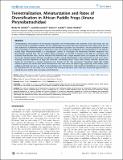| dc.contributor.author | Zimkus, Breda Marie | |
| dc.contributor.author | Lawson, Lucinda | |
| dc.contributor.author | Loader, Simon P. | |
| dc.contributor.author | Hanken, James | |
| dc.date.accessioned | 2013-10-24T18:30:57Z | |
| dc.date.issued | 2012 | |
| dc.identifier.citation | Zimkus, Breda M., Lucinda Lawson, Simon P. Loader, and James Hanken. 2012. Terrestrialization, miniaturization and rates of diversification in African puddle frogs (anura: Phrynobatrachidae). PLoS ONE 7(4): e35118. | en_US |
| dc.identifier.issn | 1932-6203 | en_US |
| dc.identifier.uri | http://nrs.harvard.edu/urn-3:HUL.InstRepos:11210598 | |
| dc.description.abstract | Terrestrialization, the evolution of non-aquatic oviposition, and miniaturization, the evolution of tiny adult body size, are recurring trends in amphibian evolution, but the relationships among the traits that characterize these phenomena are not well understood. Furthermore, these traits have been identified as possible “key innovations” that are predicted to increase rates of speciation in those lineages in which they evolve. We examine terrestrialization and miniaturization in sub-Saharan puddle frogs (Phrynobatrachidae) in a phylogenetic context to investigate the relationship between adaptation and diversification through time. We use relative dating techniques to ascertain if character trait shifts are associated with increased diversification rates, and we evaluate the likelihood that a single temporal event can explain the evolution of those traits. Results indicate alternate reproductive modes evolved independently in Phrynobatrachus at least seven times, including terrestrial deposition of eggs and terrestrial, non-feeding larvae. These shifts towards alternate reproductive modes are not linked to a common temporal event. Contrary to the “key innovations” hypothesis, clades that exhibit alternate reproductive modes have lower diversification rates than those that deposit eggs aquatically. Adult habitat, pedal webbing and body size have no effect on diversification rates. Though these traits putatively identified as key innovations for Phrynobatrachus do not seem to be associated with increased speciation rates, they may still provide opportunities to extend into new niches, thus increasing overall diversity. | en_US |
| dc.description.sponsorship | Organismic and Evolutionary Biology | en_US |
| dc.language.iso | en_US | en_US |
| dc.publisher | Public Library of Science | en_US |
| dc.relation.isversionof | doi:10.1371/journal.pone.0035118 | en_US |
| dc.relation.hasversion | http://www.ncbi.nlm.nih.gov/pmc/articles/PMC3325629/pdf/ | en_US |
| dash.license | LAA | |
| dc.subject | biology | en_US |
| dc.subject | ecology | en_US |
| dc.subject | ecological metrics | en_US |
| dc.subject | species diversity | en_US |
| dc.subject | evolutionary biology | en_US |
| dc.subject | evolutionary processes | en_US |
| dc.subject | speciation | en_US |
| dc.subject | evolutionary systematics | en_US |
| dc.subject | cladistics | en_US |
| dc.subject | phylogenetics | en_US |
| dc.subject | forms of evolution | en_US |
| dc.subject | divergent evolution | en_US |
| dc.subject | evolutionary theory | en_US |
| dc.subject | zoology | en_US |
| dc.subject | animal phylogenetics | en_US |
| dc.subject | herpetology | en_US |
| dc.title | Terrestrialization, Miniaturization and Rates of Diversification in African Puddle Frogs (Anura: Phrynobatrachidae) | en_US |
| dc.type | Journal Article | en_US |
| dc.description.version | Version of Record | en_US |
| dc.relation.journal | PLoS ONE | en_US |
| dash.depositing.author | Hanken, James | |
| dc.date.available | 2013-10-24T18:30:57Z | |
| dc.identifier.doi | 10.1371/journal.pone.0035118 | * |
| dash.contributor.affiliated | Zimkus, Breda | |
| dash.contributor.affiliated | Hanken, James | |


